Taxation Law: Evaluation of Assets under Income Tax Assessment Act 1997
VerifiedAdded on 2023/06/04
|9
|2926
|130
AI Summary
This article evaluates the definition of personal use assets and collectables, and the capital gains tax events that result in capital gain or loss. It discusses the evaluation of assets under Income Tax Assessment Act 1997, including jewellery, second-hand cars, shares, and homes.
Contribute Materials
Your contribution can guide someone’s learning journey. Share your
documents today.
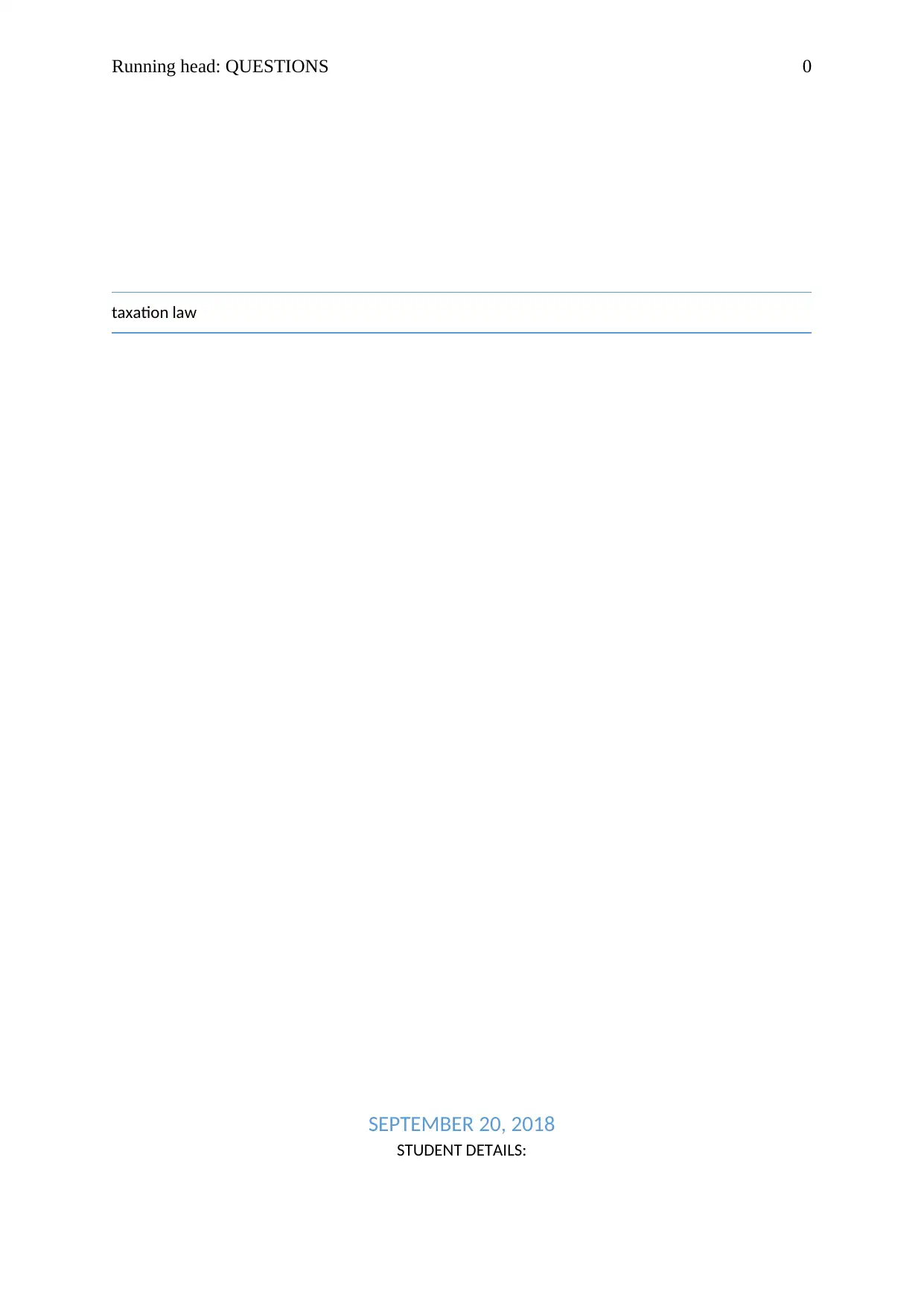
Running head: QUESTIONS 0
taxation law
SEPTEMBER 20, 2018
STUDENT DETAILS:
taxation law
SEPTEMBER 20, 2018
STUDENT DETAILS:
Secure Best Marks with AI Grader
Need help grading? Try our AI Grader for instant feedback on your assignments.

QUESTIONS 1
(a) A jewellery costs $5000–
It is collectable. The word ‘collectable’ is described in the section 108-10(2) of the Income
Tax Assessment Act 1997 (ITAA 97) (Trivino, 2017). The word collectable refers to the
jewellery, the antique item, artwork like painting or drawing, rare folio, medals, coins,
postage, books, and first day cover, which is utilised or retained for use personally or for the
enjoyment, as well as to interests in and choice to obtain these things and the responsibility
rising from these things (Lehmann, 2015).
(b) A second-hand car purchased for $3000 –
If a car is for the personal use, in this case the car will be the personal use asset as per the
section 108-20(2) of the Income Tax Assessment Act 1997 (ITAA 97). However, a capital
gain or capital loss incurred from the car is exempt. The word ‘personal use asset’ is
described in the section 108-20(2) of the Income Tax Assessment Act 1997 (ITAA 97)
(Diebold, 2015). The term ‘personal use asset’ means a CGT asset (not applicable on
collectable asset), which is utilised or retained majorly for the personal use or for the
enjoyment, as well as to choices to obtain these assets or possessions and definite debts
(Coombes, 2015).
In each case, the description needs an evaluation of first and basic use of the asset in the place
of making focus on the core value of the asset. It is found by the committee that the bill
drafting was planned to take asset of the category which are generally utilised for the
enjoyment personally, but not asset which is really utilised in this manner or procedure. The
main reason is that the superannuation funds are in major barred from taking or purchasing
and maintaining personal use asset and collectables by the function of the section 62 of the
(a) A jewellery costs $5000–
It is collectable. The word ‘collectable’ is described in the section 108-10(2) of the Income
Tax Assessment Act 1997 (ITAA 97) (Trivino, 2017). The word collectable refers to the
jewellery, the antique item, artwork like painting or drawing, rare folio, medals, coins,
postage, books, and first day cover, which is utilised or retained for use personally or for the
enjoyment, as well as to interests in and choice to obtain these things and the responsibility
rising from these things (Lehmann, 2015).
(b) A second-hand car purchased for $3000 –
If a car is for the personal use, in this case the car will be the personal use asset as per the
section 108-20(2) of the Income Tax Assessment Act 1997 (ITAA 97). However, a capital
gain or capital loss incurred from the car is exempt. The word ‘personal use asset’ is
described in the section 108-20(2) of the Income Tax Assessment Act 1997 (ITAA 97)
(Diebold, 2015). The term ‘personal use asset’ means a CGT asset (not applicable on
collectable asset), which is utilised or retained majorly for the personal use or for the
enjoyment, as well as to choices to obtain these assets or possessions and definite debts
(Coombes, 2015).
In each case, the description needs an evaluation of first and basic use of the asset in the place
of making focus on the core value of the asset. It is found by the committee that the bill
drafting was planned to take asset of the category which are generally utilised for the
enjoyment personally, but not asset which is really utilised in this manner or procedure. The
main reason is that the superannuation funds are in major barred from taking or purchasing
and maintaining personal use asset and collectables by the function of the section 62 of the
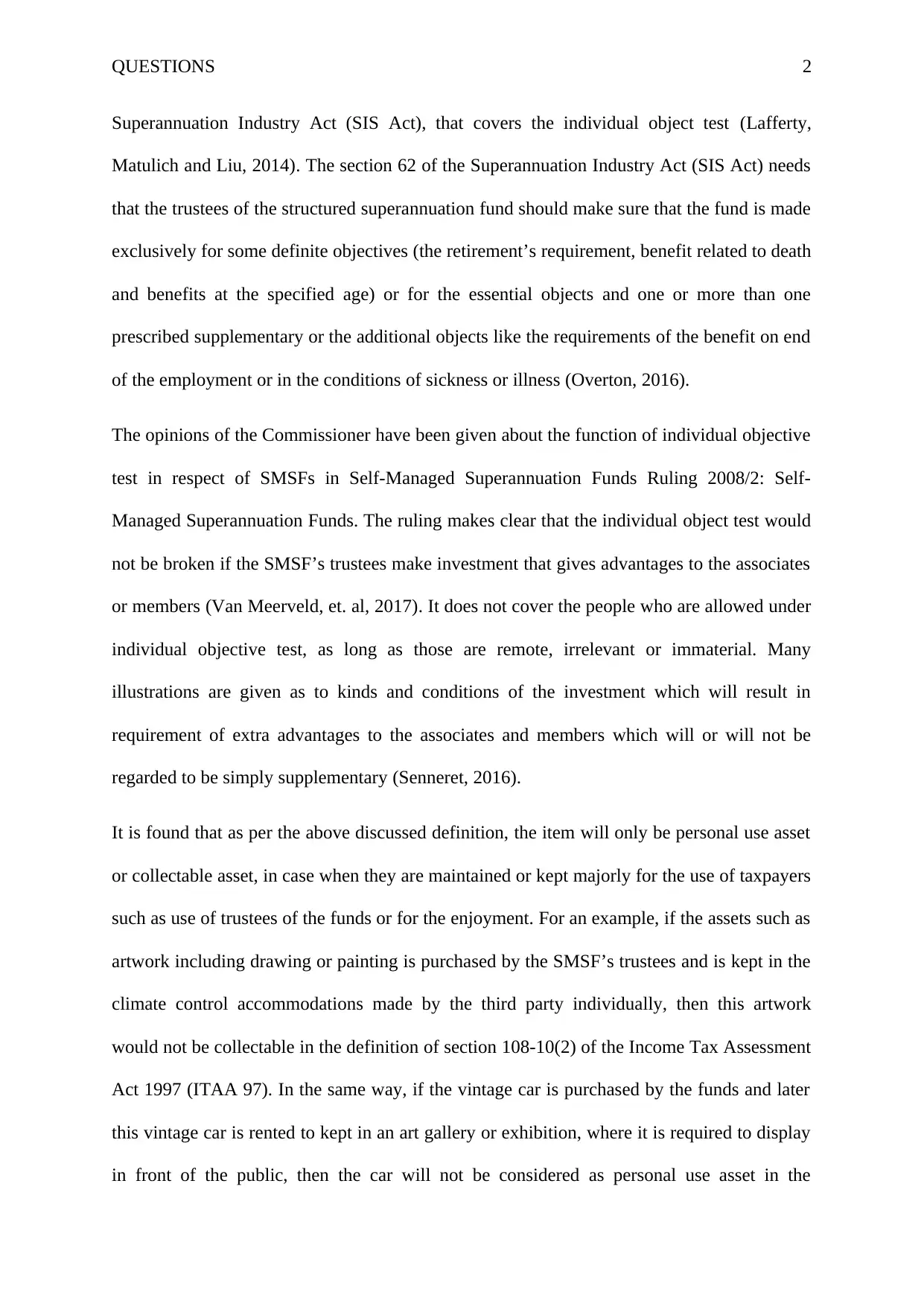
QUESTIONS 2
Superannuation Industry Act (SIS Act), that covers the individual object test (Lafferty,
Matulich and Liu, 2014). The section 62 of the Superannuation Industry Act (SIS Act) needs
that the trustees of the structured superannuation fund should make sure that the fund is made
exclusively for some definite objectives (the retirement’s requirement, benefit related to death
and benefits at the specified age) or for the essential objects and one or more than one
prescribed supplementary or the additional objects like the requirements of the benefit on end
of the employment or in the conditions of sickness or illness (Overton, 2016).
The opinions of the Commissioner have been given about the function of individual objective
test in respect of SMSFs in Self-Managed Superannuation Funds Ruling 2008/2: Self-
Managed Superannuation Funds. The ruling makes clear that the individual object test would
not be broken if the SMSF’s trustees make investment that gives advantages to the associates
or members (Van Meerveld, et. al, 2017). It does not cover the people who are allowed under
individual objective test, as long as those are remote, irrelevant or immaterial. Many
illustrations are given as to kinds and conditions of the investment which will result in
requirement of extra advantages to the associates and members which will or will not be
regarded to be simply supplementary (Senneret, 2016).
It is found that as per the above discussed definition, the item will only be personal use asset
or collectable asset, in case when they are maintained or kept majorly for the use of taxpayers
such as use of trustees of the funds or for the enjoyment. For an example, if the assets such as
artwork including drawing or painting is purchased by the SMSF’s trustees and is kept in the
climate control accommodations made by the third party individually, then this artwork
would not be collectable in the definition of section 108-10(2) of the Income Tax Assessment
Act 1997 (ITAA 97). In the same way, if the vintage car is purchased by the funds and later
this vintage car is rented to kept in an art gallery or exhibition, where it is required to display
in front of the public, then the car will not be considered as personal use asset in the
Superannuation Industry Act (SIS Act), that covers the individual object test (Lafferty,
Matulich and Liu, 2014). The section 62 of the Superannuation Industry Act (SIS Act) needs
that the trustees of the structured superannuation fund should make sure that the fund is made
exclusively for some definite objectives (the retirement’s requirement, benefit related to death
and benefits at the specified age) or for the essential objects and one or more than one
prescribed supplementary or the additional objects like the requirements of the benefit on end
of the employment or in the conditions of sickness or illness (Overton, 2016).
The opinions of the Commissioner have been given about the function of individual objective
test in respect of SMSFs in Self-Managed Superannuation Funds Ruling 2008/2: Self-
Managed Superannuation Funds. The ruling makes clear that the individual object test would
not be broken if the SMSF’s trustees make investment that gives advantages to the associates
or members (Van Meerveld, et. al, 2017). It does not cover the people who are allowed under
individual objective test, as long as those are remote, irrelevant or immaterial. Many
illustrations are given as to kinds and conditions of the investment which will result in
requirement of extra advantages to the associates and members which will or will not be
regarded to be simply supplementary (Senneret, 2016).
It is found that as per the above discussed definition, the item will only be personal use asset
or collectable asset, in case when they are maintained or kept majorly for the use of taxpayers
such as use of trustees of the funds or for the enjoyment. For an example, if the assets such as
artwork including drawing or painting is purchased by the SMSF’s trustees and is kept in the
climate control accommodations made by the third party individually, then this artwork
would not be collectable in the definition of section 108-10(2) of the Income Tax Assessment
Act 1997 (ITAA 97). In the same way, if the vintage car is purchased by the funds and later
this vintage car is rented to kept in an art gallery or exhibition, where it is required to display
in front of the public, then the car will not be considered as personal use asset in the
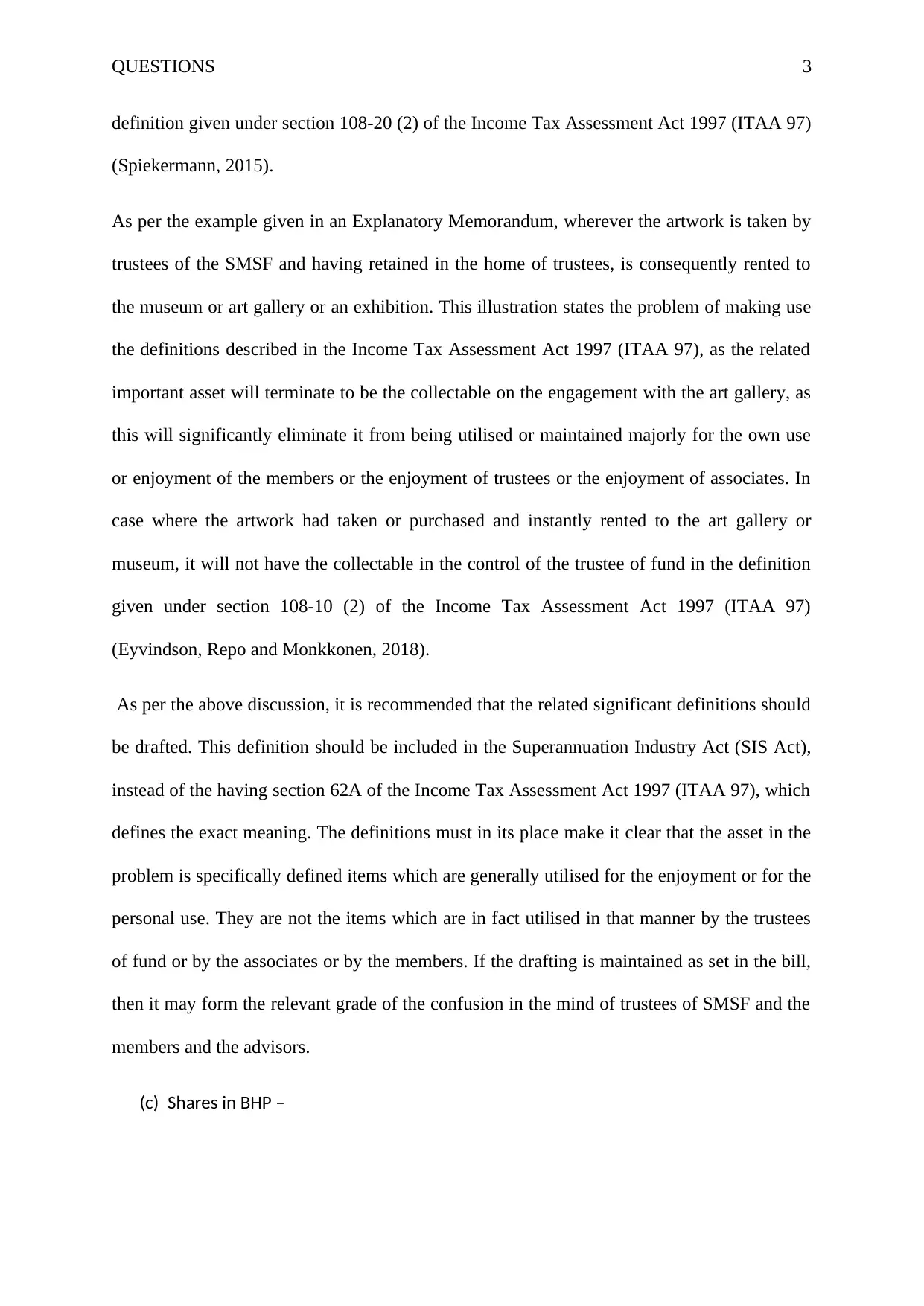
QUESTIONS 3
definition given under section 108-20 (2) of the Income Tax Assessment Act 1997 (ITAA 97)
(Spiekermann, 2015).
As per the example given in an Explanatory Memorandum, wherever the artwork is taken by
trustees of the SMSF and having retained in the home of trustees, is consequently rented to
the museum or art gallery or an exhibition. This illustration states the problem of making use
the definitions described in the Income Tax Assessment Act 1997 (ITAA 97), as the related
important asset will terminate to be the collectable on the engagement with the art gallery, as
this will significantly eliminate it from being utilised or maintained majorly for the own use
or enjoyment of the members or the enjoyment of trustees or the enjoyment of associates. In
case where the artwork had taken or purchased and instantly rented to the art gallery or
museum, it will not have the collectable in the control of the trustee of fund in the definition
given under section 108-10 (2) of the Income Tax Assessment Act 1997 (ITAA 97)
(Eyvindson, Repo and Monkkonen, 2018).
As per the above discussion, it is recommended that the related significant definitions should
be drafted. This definition should be included in the Superannuation Industry Act (SIS Act),
instead of the having section 62A of the Income Tax Assessment Act 1997 (ITAA 97), which
defines the exact meaning. The definitions must in its place make it clear that the asset in the
problem is specifically defined items which are generally utilised for the enjoyment or for the
personal use. They are not the items which are in fact utilised in that manner by the trustees
of fund or by the associates or by the members. If the drafting is maintained as set in the bill,
then it may form the relevant grade of the confusion in the mind of trustees of SMSF and the
members and the advisors.
(c) Shares in BHP –
definition given under section 108-20 (2) of the Income Tax Assessment Act 1997 (ITAA 97)
(Spiekermann, 2015).
As per the example given in an Explanatory Memorandum, wherever the artwork is taken by
trustees of the SMSF and having retained in the home of trustees, is consequently rented to
the museum or art gallery or an exhibition. This illustration states the problem of making use
the definitions described in the Income Tax Assessment Act 1997 (ITAA 97), as the related
important asset will terminate to be the collectable on the engagement with the art gallery, as
this will significantly eliminate it from being utilised or maintained majorly for the own use
or enjoyment of the members or the enjoyment of trustees or the enjoyment of associates. In
case where the artwork had taken or purchased and instantly rented to the art gallery or
museum, it will not have the collectable in the control of the trustee of fund in the definition
given under section 108-10 (2) of the Income Tax Assessment Act 1997 (ITAA 97)
(Eyvindson, Repo and Monkkonen, 2018).
As per the above discussion, it is recommended that the related significant definitions should
be drafted. This definition should be included in the Superannuation Industry Act (SIS Act),
instead of the having section 62A of the Income Tax Assessment Act 1997 (ITAA 97), which
defines the exact meaning. The definitions must in its place make it clear that the asset in the
problem is specifically defined items which are generally utilised for the enjoyment or for the
personal use. They are not the items which are in fact utilised in that manner by the trustees
of fund or by the associates or by the members. If the drafting is maintained as set in the bill,
then it may form the relevant grade of the confusion in the mind of trustees of SMSF and the
members and the advisors.
(c) Shares in BHP –
Secure Best Marks with AI Grader
Need help grading? Try our AI Grader for instant feedback on your assignments.
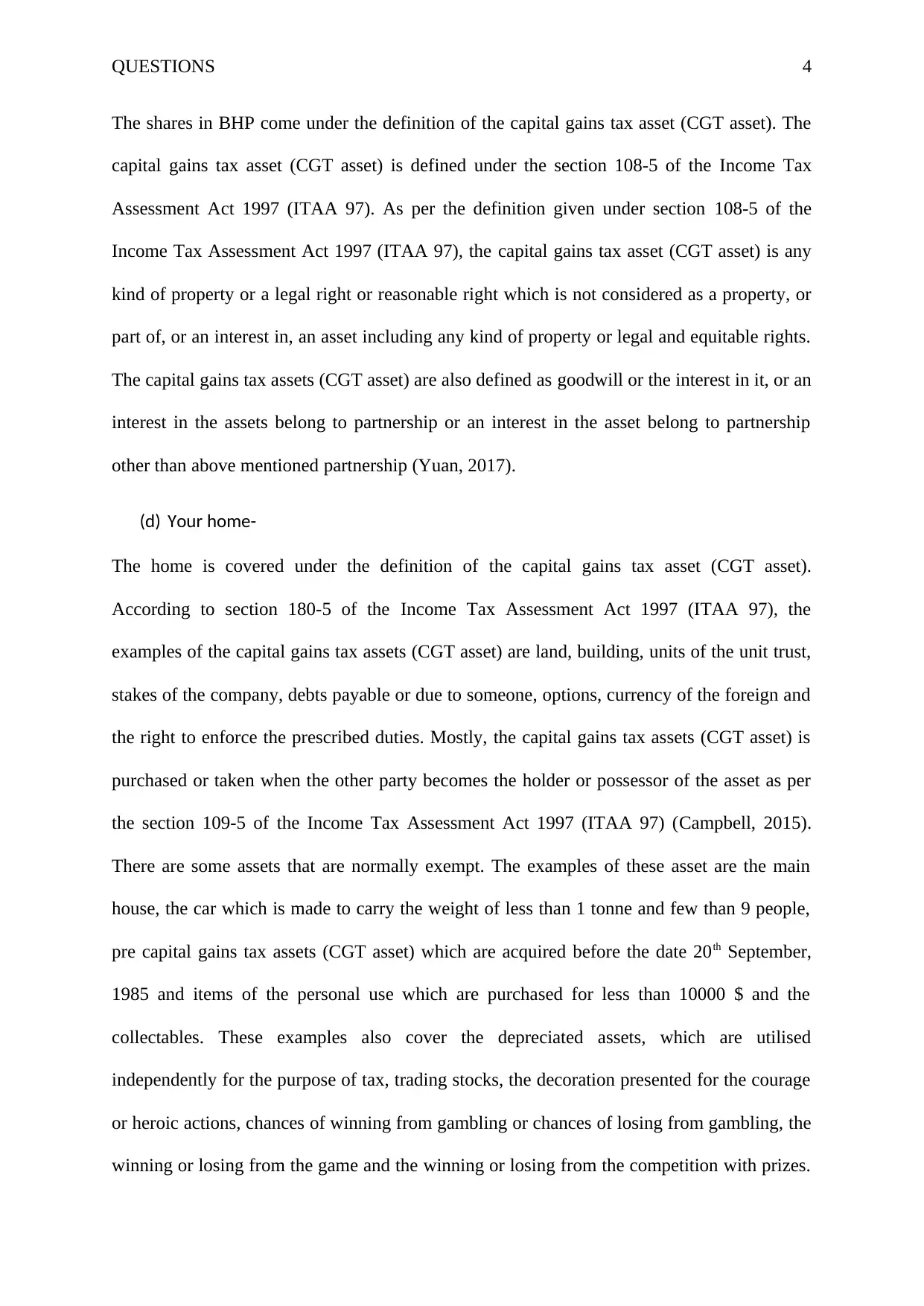
QUESTIONS 4
The shares in BHP come under the definition of the capital gains tax asset (CGT asset). The
capital gains tax asset (CGT asset) is defined under the section 108-5 of the Income Tax
Assessment Act 1997 (ITAA 97). As per the definition given under section 108-5 of the
Income Tax Assessment Act 1997 (ITAA 97), the capital gains tax asset (CGT asset) is any
kind of property or a legal right or reasonable right which is not considered as a property, or
part of, or an interest in, an asset including any kind of property or legal and equitable rights.
The capital gains tax assets (CGT asset) are also defined as goodwill or the interest in it, or an
interest in the assets belong to partnership or an interest in the asset belong to partnership
other than above mentioned partnership (Yuan, 2017).
(d) Your home-
The home is covered under the definition of the capital gains tax asset (CGT asset).
According to section 180-5 of the Income Tax Assessment Act 1997 (ITAA 97), the
examples of the capital gains tax assets (CGT asset) are land, building, units of the unit trust,
stakes of the company, debts payable or due to someone, options, currency of the foreign and
the right to enforce the prescribed duties. Mostly, the capital gains tax assets (CGT asset) is
purchased or taken when the other party becomes the holder or possessor of the asset as per
the section 109-5 of the Income Tax Assessment Act 1997 (ITAA 97) (Campbell, 2015).
There are some assets that are normally exempt. The examples of these asset are the main
house, the car which is made to carry the weight of less than 1 tonne and few than 9 people,
pre capital gains tax assets (CGT asset) which are acquired before the date 20th September,
1985 and items of the personal use which are purchased for less than 10000 $ and the
collectables. These examples also cover the depreciated assets, which are utilised
independently for the purpose of tax, trading stocks, the decoration presented for the courage
or heroic actions, chances of winning from gambling or chances of losing from gambling, the
winning or losing from the game and the winning or losing from the competition with prizes.
The shares in BHP come under the definition of the capital gains tax asset (CGT asset). The
capital gains tax asset (CGT asset) is defined under the section 108-5 of the Income Tax
Assessment Act 1997 (ITAA 97). As per the definition given under section 108-5 of the
Income Tax Assessment Act 1997 (ITAA 97), the capital gains tax asset (CGT asset) is any
kind of property or a legal right or reasonable right which is not considered as a property, or
part of, or an interest in, an asset including any kind of property or legal and equitable rights.
The capital gains tax assets (CGT asset) are also defined as goodwill or the interest in it, or an
interest in the assets belong to partnership or an interest in the asset belong to partnership
other than above mentioned partnership (Yuan, 2017).
(d) Your home-
The home is covered under the definition of the capital gains tax asset (CGT asset).
According to section 180-5 of the Income Tax Assessment Act 1997 (ITAA 97), the
examples of the capital gains tax assets (CGT asset) are land, building, units of the unit trust,
stakes of the company, debts payable or due to someone, options, currency of the foreign and
the right to enforce the prescribed duties. Mostly, the capital gains tax assets (CGT asset) is
purchased or taken when the other party becomes the holder or possessor of the asset as per
the section 109-5 of the Income Tax Assessment Act 1997 (ITAA 97) (Campbell, 2015).
There are some assets that are normally exempt. The examples of these asset are the main
house, the car which is made to carry the weight of less than 1 tonne and few than 9 people,
pre capital gains tax assets (CGT asset) which are acquired before the date 20th September,
1985 and items of the personal use which are purchased for less than 10000 $ and the
collectables. These examples also cover the depreciated assets, which are utilised
independently for the purpose of tax, trading stocks, the decoration presented for the courage
or heroic actions, chances of winning from gambling or chances of losing from gambling, the
winning or losing from the game and the winning or losing from the competition with prizes.
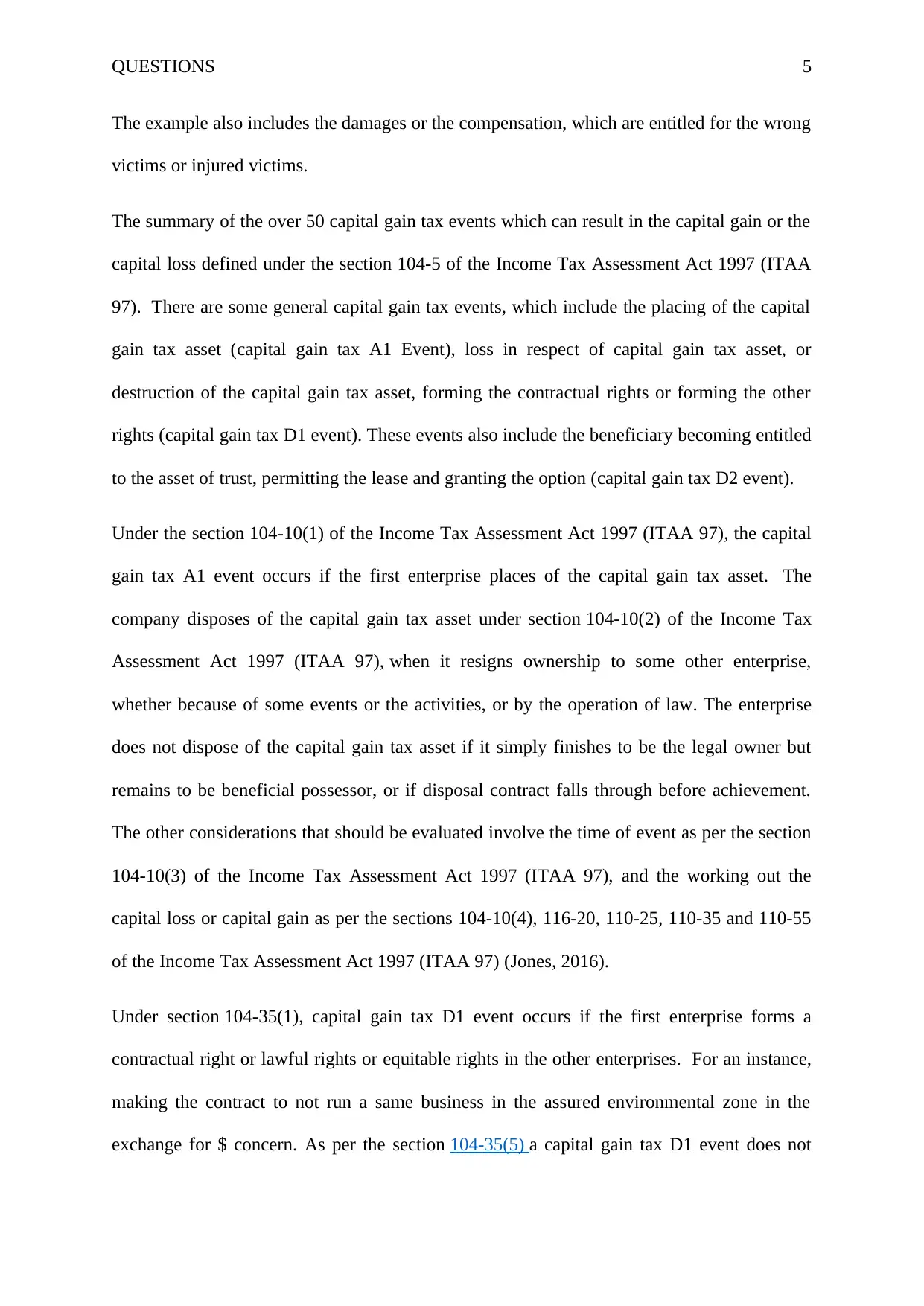
QUESTIONS 5
The example also includes the damages or the compensation, which are entitled for the wrong
victims or injured victims.
The summary of the over 50 capital gain tax events which can result in the capital gain or the
capital loss defined under the section 104-5 of the Income Tax Assessment Act 1997 (ITAA
97). There are some general capital gain tax events, which include the placing of the capital
gain tax asset (capital gain tax A1 Event), loss in respect of capital gain tax asset, or
destruction of the capital gain tax asset, forming the contractual rights or forming the other
rights (capital gain tax D1 event). These events also include the beneficiary becoming entitled
to the asset of trust, permitting the lease and granting the option (capital gain tax D2 event).
Under the section 104-10(1) of the Income Tax Assessment Act 1997 (ITAA 97), the capital
gain tax A1 event occurs if the first enterprise places of the capital gain tax asset. The
company disposes of the capital gain tax asset under section 104-10(2) of the Income Tax
Assessment Act 1997 (ITAA 97), when it resigns ownership to some other enterprise,
whether because of some events or the activities, or by the operation of law. The enterprise
does not dispose of the capital gain tax asset if it simply finishes to be the legal owner but
remains to be beneficial possessor, or if disposal contract falls through before achievement.
The other considerations that should be evaluated involve the time of event as per the section
104-10(3) of the Income Tax Assessment Act 1997 (ITAA 97), and the working out the
capital loss or capital gain as per the sections 104-10(4), 116-20, 110-25, 110-35 and 110-55
of the Income Tax Assessment Act 1997 (ITAA 97) (Jones, 2016).
Under section 104-35(1), capital gain tax D1 event occurs if the first enterprise forms a
contractual right or lawful rights or equitable rights in the other enterprises. For an instance,
making the contract to not run a same business in the assured environmental zone in the
exchange for $ concern. As per the section 104-35(5) a capital gain tax D1 event does not
The example also includes the damages or the compensation, which are entitled for the wrong
victims or injured victims.
The summary of the over 50 capital gain tax events which can result in the capital gain or the
capital loss defined under the section 104-5 of the Income Tax Assessment Act 1997 (ITAA
97). There are some general capital gain tax events, which include the placing of the capital
gain tax asset (capital gain tax A1 Event), loss in respect of capital gain tax asset, or
destruction of the capital gain tax asset, forming the contractual rights or forming the other
rights (capital gain tax D1 event). These events also include the beneficiary becoming entitled
to the asset of trust, permitting the lease and granting the option (capital gain tax D2 event).
Under the section 104-10(1) of the Income Tax Assessment Act 1997 (ITAA 97), the capital
gain tax A1 event occurs if the first enterprise places of the capital gain tax asset. The
company disposes of the capital gain tax asset under section 104-10(2) of the Income Tax
Assessment Act 1997 (ITAA 97), when it resigns ownership to some other enterprise,
whether because of some events or the activities, or by the operation of law. The enterprise
does not dispose of the capital gain tax asset if it simply finishes to be the legal owner but
remains to be beneficial possessor, or if disposal contract falls through before achievement.
The other considerations that should be evaluated involve the time of event as per the section
104-10(3) of the Income Tax Assessment Act 1997 (ITAA 97), and the working out the
capital loss or capital gain as per the sections 104-10(4), 116-20, 110-25, 110-35 and 110-55
of the Income Tax Assessment Act 1997 (ITAA 97) (Jones, 2016).
Under section 104-35(1), capital gain tax D1 event occurs if the first enterprise forms a
contractual right or lawful rights or equitable rights in the other enterprises. For an instance,
making the contract to not run a same business in the assured environmental zone in the
exchange for $ concern. As per the section 104-35(5) a capital gain tax D1 event does not
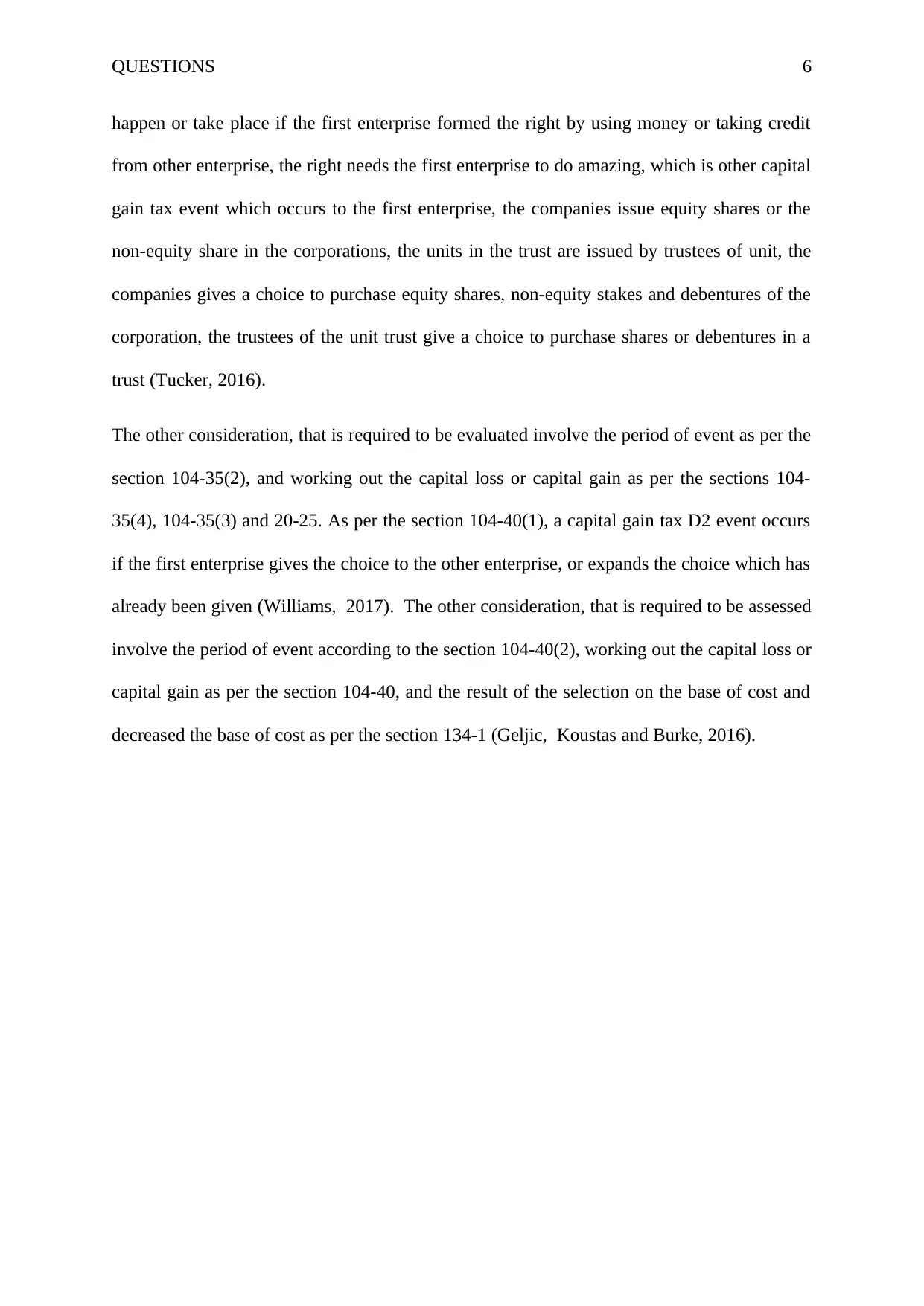
QUESTIONS 6
happen or take place if the first enterprise formed the right by using money or taking credit
from other enterprise, the right needs the first enterprise to do amazing, which is other capital
gain tax event which occurs to the first enterprise, the companies issue equity shares or the
non-equity share in the corporations, the units in the trust are issued by trustees of unit, the
companies gives a choice to purchase equity shares, non-equity stakes and debentures of the
corporation, the trustees of the unit trust give a choice to purchase shares or debentures in a
trust (Tucker, 2016).
The other consideration, that is required to be evaluated involve the period of event as per the
section 104-35(2), and working out the capital loss or capital gain as per the sections 104-
35(4), 104-35(3) and 20-25. As per the section 104-40(1), a capital gain tax D2 event occurs
if the first enterprise gives the choice to the other enterprise, or expands the choice which has
already been given (Williams, 2017). The other consideration, that is required to be assessed
involve the period of event according to the section 104-40(2), working out the capital loss or
capital gain as per the section 104-40, and the result of the selection on the base of cost and
decreased the base of cost as per the section 134-1 (Geljic, Koustas and Burke, 2016).
happen or take place if the first enterprise formed the right by using money or taking credit
from other enterprise, the right needs the first enterprise to do amazing, which is other capital
gain tax event which occurs to the first enterprise, the companies issue equity shares or the
non-equity share in the corporations, the units in the trust are issued by trustees of unit, the
companies gives a choice to purchase equity shares, non-equity stakes and debentures of the
corporation, the trustees of the unit trust give a choice to purchase shares or debentures in a
trust (Tucker, 2016).
The other consideration, that is required to be evaluated involve the period of event as per the
section 104-35(2), and working out the capital loss or capital gain as per the sections 104-
35(4), 104-35(3) and 20-25. As per the section 104-40(1), a capital gain tax D2 event occurs
if the first enterprise gives the choice to the other enterprise, or expands the choice which has
already been given (Williams, 2017). The other consideration, that is required to be assessed
involve the period of event according to the section 104-40(2), working out the capital loss or
capital gain as per the section 104-40, and the result of the selection on the base of cost and
decreased the base of cost as per the section 134-1 (Geljic, Koustas and Burke, 2016).
Paraphrase This Document
Need a fresh take? Get an instant paraphrase of this document with our AI Paraphraser
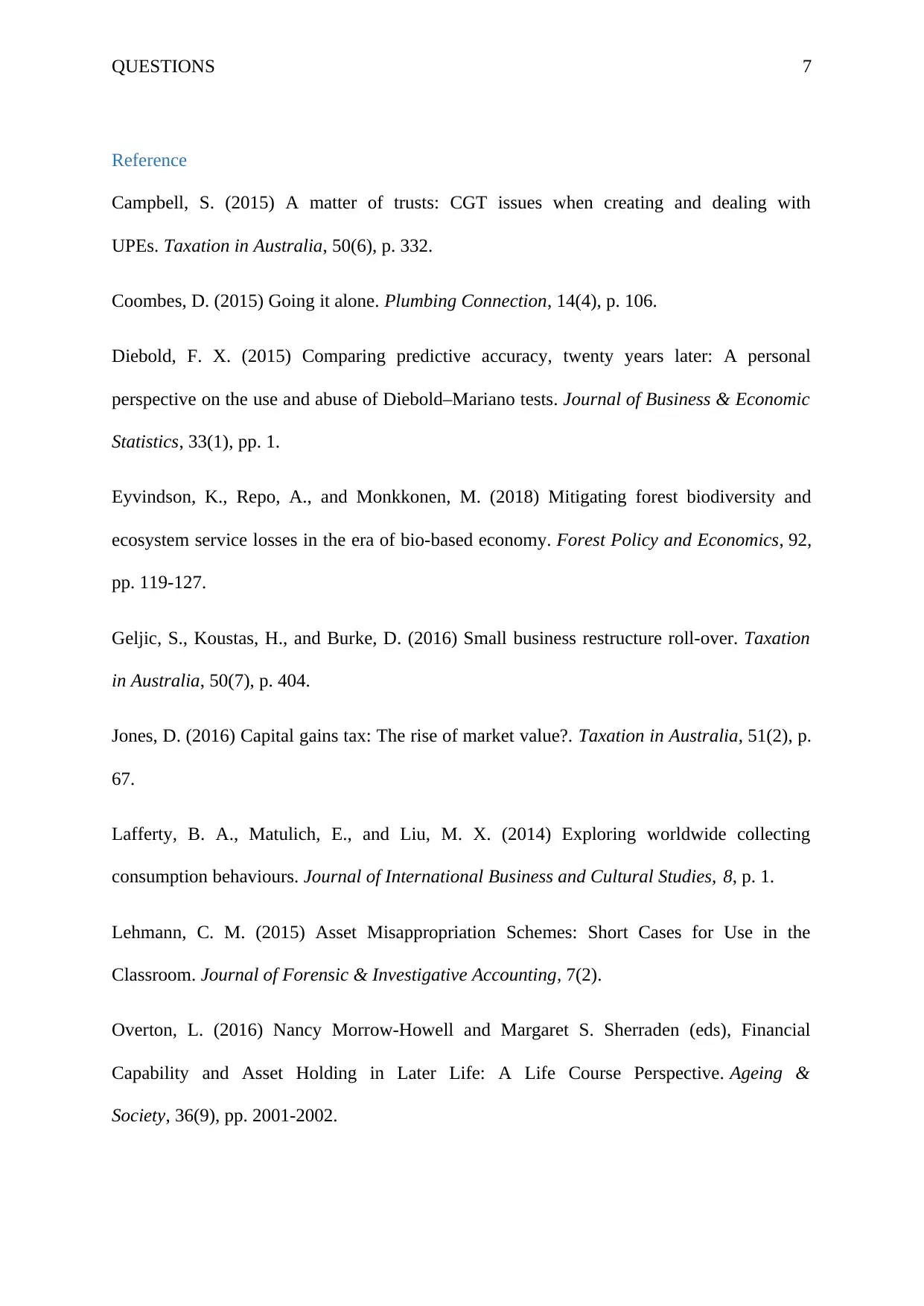
QUESTIONS 7
Reference
Campbell, S. (2015) A matter of trusts: CGT issues when creating and dealing with
UPEs. Taxation in Australia, 50(6), p. 332.
Coombes, D. (2015) Going it alone. Plumbing Connection, 14(4), p. 106.
Diebold, F. X. (2015) Comparing predictive accuracy, twenty years later: A personal
perspective on the use and abuse of Diebold–Mariano tests. Journal of Business & Economic
Statistics, 33(1), pp. 1.
Eyvindson, K., Repo, A., and Monkkonen, M. (2018) Mitigating forest biodiversity and
ecosystem service losses in the era of bio-based economy. Forest Policy and Economics, 92,
pp. 119-127.
Geljic, S., Koustas, H., and Burke, D. (2016) Small business restructure roll-over. Taxation
in Australia, 50(7), p. 404.
Jones, D. (2016) Capital gains tax: The rise of market value?. Taxation in Australia, 51(2), p.
67.
Lafferty, B. A., Matulich, E., and Liu, M. X. (2014) Exploring worldwide collecting
consumption behaviours. Journal of International Business and Cultural Studies, 8, p. 1.
Lehmann, C. M. (2015) Asset Misappropriation Schemes: Short Cases for Use in the
Classroom. Journal of Forensic & Investigative Accounting, 7(2).
Overton, L. (2016) Nancy Morrow-Howell and Margaret S. Sherraden (eds), Financial
Capability and Asset Holding in Later Life: A Life Course Perspective. Ageing &
Society, 36(9), pp. 2001-2002.
Reference
Campbell, S. (2015) A matter of trusts: CGT issues when creating and dealing with
UPEs. Taxation in Australia, 50(6), p. 332.
Coombes, D. (2015) Going it alone. Plumbing Connection, 14(4), p. 106.
Diebold, F. X. (2015) Comparing predictive accuracy, twenty years later: A personal
perspective on the use and abuse of Diebold–Mariano tests. Journal of Business & Economic
Statistics, 33(1), pp. 1.
Eyvindson, K., Repo, A., and Monkkonen, M. (2018) Mitigating forest biodiversity and
ecosystem service losses in the era of bio-based economy. Forest Policy and Economics, 92,
pp. 119-127.
Geljic, S., Koustas, H., and Burke, D. (2016) Small business restructure roll-over. Taxation
in Australia, 50(7), p. 404.
Jones, D. (2016) Capital gains tax: The rise of market value?. Taxation in Australia, 51(2), p.
67.
Lafferty, B. A., Matulich, E., and Liu, M. X. (2014) Exploring worldwide collecting
consumption behaviours. Journal of International Business and Cultural Studies, 8, p. 1.
Lehmann, C. M. (2015) Asset Misappropriation Schemes: Short Cases for Use in the
Classroom. Journal of Forensic & Investigative Accounting, 7(2).
Overton, L. (2016) Nancy Morrow-Howell and Margaret S. Sherraden (eds), Financial
Capability and Asset Holding in Later Life: A Life Course Perspective. Ageing &
Society, 36(9), pp. 2001-2002.
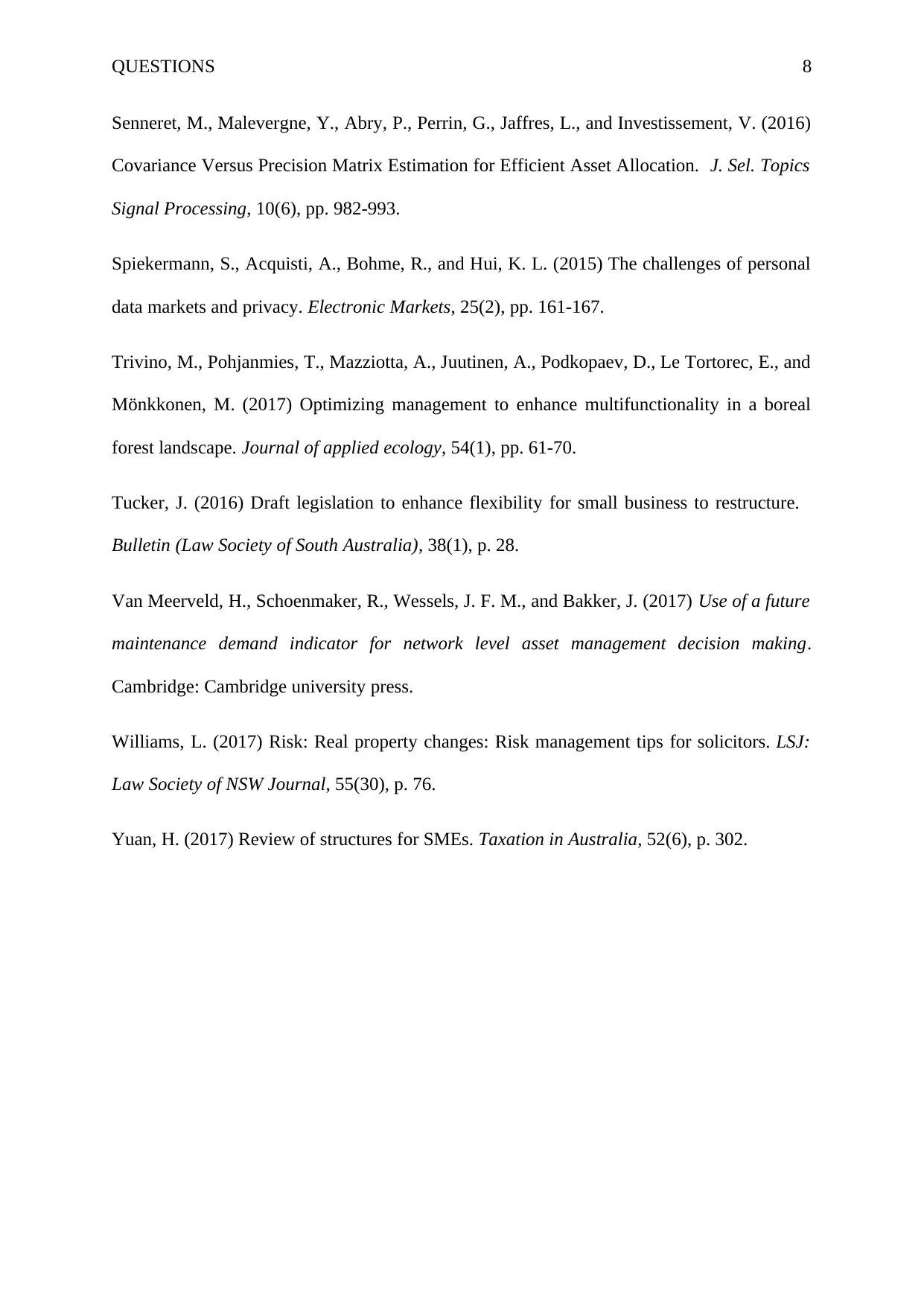
QUESTIONS 8
Senneret, M., Malevergne, Y., Abry, P., Perrin, G., Jaffres, L., and Investissement, V. (2016)
Covariance Versus Precision Matrix Estimation for Efficient Asset Allocation. J. Sel. Topics
Signal Processing, 10(6), pp. 982-993.
Spiekermann, S., Acquisti, A., Bohme, R., and Hui, K. L. (2015) The challenges of personal
data markets and privacy. Electronic Markets, 25(2), pp. 161-167.
Trivino, M., Pohjanmies, T., Mazziotta, A., Juutinen, A., Podkopaev, D., Le Tortorec, E., and
Mönkkonen, M. (2017) Optimizing management to enhance multifunctionality in a boreal
forest landscape. Journal of applied ecology, 54(1), pp. 61-70.
Tucker, J. (2016) Draft legislation to enhance flexibility for small business to restructure.
Bulletin (Law Society of South Australia), 38(1), p. 28.
Van Meerveld, H., Schoenmaker, R., Wessels, J. F. M., and Bakker, J. (2017) Use of a future
maintenance demand indicator for network level asset management decision making.
Cambridge: Cambridge university press.
Williams, L. (2017) Risk: Real property changes: Risk management tips for solicitors. LSJ:
Law Society of NSW Journal, 55(30), p. 76.
Yuan, H. (2017) Review of structures for SMEs. Taxation in Australia, 52(6), p. 302.
Senneret, M., Malevergne, Y., Abry, P., Perrin, G., Jaffres, L., and Investissement, V. (2016)
Covariance Versus Precision Matrix Estimation for Efficient Asset Allocation. J. Sel. Topics
Signal Processing, 10(6), pp. 982-993.
Spiekermann, S., Acquisti, A., Bohme, R., and Hui, K. L. (2015) The challenges of personal
data markets and privacy. Electronic Markets, 25(2), pp. 161-167.
Trivino, M., Pohjanmies, T., Mazziotta, A., Juutinen, A., Podkopaev, D., Le Tortorec, E., and
Mönkkonen, M. (2017) Optimizing management to enhance multifunctionality in a boreal
forest landscape. Journal of applied ecology, 54(1), pp. 61-70.
Tucker, J. (2016) Draft legislation to enhance flexibility for small business to restructure.
Bulletin (Law Society of South Australia), 38(1), p. 28.
Van Meerveld, H., Schoenmaker, R., Wessels, J. F. M., and Bakker, J. (2017) Use of a future
maintenance demand indicator for network level asset management decision making.
Cambridge: Cambridge university press.
Williams, L. (2017) Risk: Real property changes: Risk management tips for solicitors. LSJ:
Law Society of NSW Journal, 55(30), p. 76.
Yuan, H. (2017) Review of structures for SMEs. Taxation in Australia, 52(6), p. 302.
1 out of 9
Related Documents
Your All-in-One AI-Powered Toolkit for Academic Success.
+13062052269
info@desklib.com
Available 24*7 on WhatsApp / Email
![[object Object]](/_next/static/media/star-bottom.7253800d.svg)
Unlock your academic potential
© 2024 | Zucol Services PVT LTD | All rights reserved.





